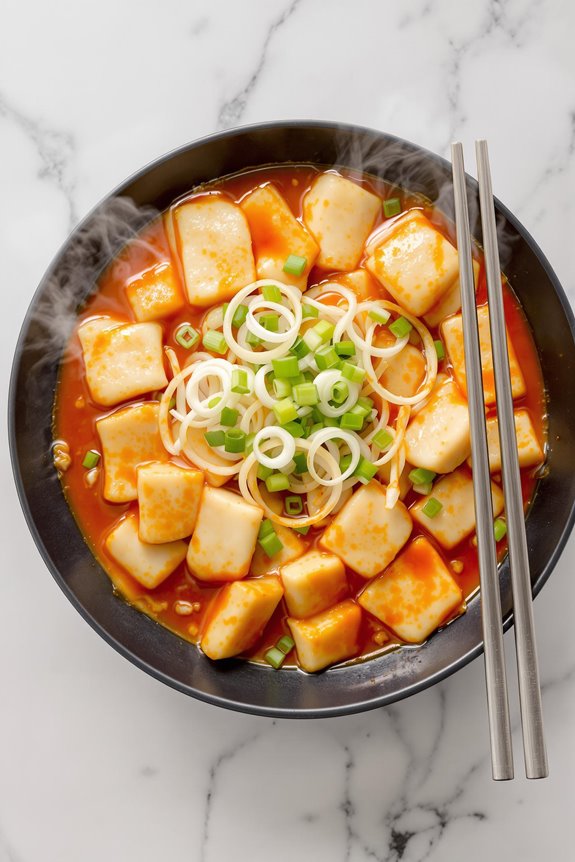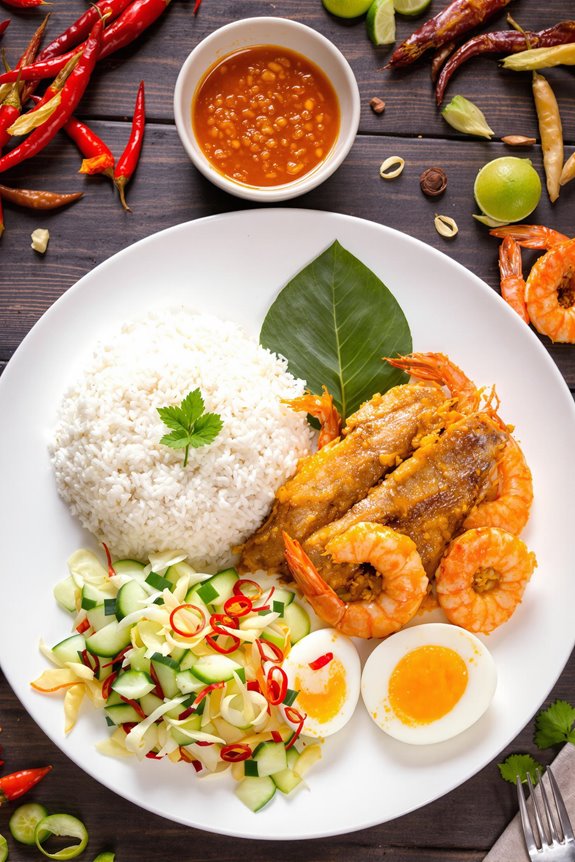I’ll give you the damn foolproof chawanmushi recipe that’ll make you obsessed with this jiggly egg custard — whisk 4 eggs with 100ml dashi water and 2ml shiro dashi until mirror-smooth, add mirin, sake, and light soy sauce, strain out every single egg bit (trust me on this), fill cups with kamaboko and shiitake pieces, then steam for 12-15 minutes until that silky texture makes you close your eyes and wonder how something so simple tastes like pure umami heaven, and I’ve got all the insider tips below.
Why You’ll Love this Silky Japanese Chawanmushi
When I first tried chawanmushi at this tiny Japanese joint in Chinatown, I thought I’d ordered the wrong thing — like, what the heck is this jiggly egg custard situation, right?
But damn, one spoonful and I was absolutely hooked. This silky, savory custard literally melts on your tongue, and those hidden treasures — mushrooms, kamaboko, gingko nuts — it’s like a freaking edible surprise box.
The texture’s so smooth it’s almost criminal, and that umami-rich dashi flavor? Chef’s kiss.
Trust me lah, once you nail this recipe, you’ll be making it weekly.
What Ingredients are in Silky Japanese Chawanmushi?
Look, I’m not gonna lie to you — when I first saw this ingredient list, I was like “what the heck is half this stuff?”
But here’s the thing about chawanmushi: it’s basically a fancy egg custard that uses some pretty specific Japanese ingredients to get that silky, umami-packed flavor that’ll make your taste buds do a happy dance.
- 4 eggs
- 2 tbsp salt
- 2 cups mirin
- 1 cup sake
- 1 cup uchicoshi shoyu (light soy sauce)
- 100 ml dashi water
- 2 ml shiro dashi
- 1 Japanese fish cake (kamaboko)
- 1 bunch shiitake mushrooms
- 1 gingko nut
- 1 chicken cube
Now, before you panic about finding some of these ingredients, let me break it down for you.
The mirin and sake might seem like a lot, but they’re what give this custard that subtle sweetness and depth — you can find them at most Asian grocery stores or even some regular supermarkets these days.
The kamaboko is that pretty pink and white fish cake that looks almost too cute to eat, and gingko nuts have this unique, slightly bitter flavor that balances everything out.
If you’re scratching your head about the difference between regular dashi and shiro dashi, don’t stress — shiro dashi is just the lighter, more refined version that keeps your custard looking pristine and pale.
And yeah, that chicken cube is doing some serious flavor heavy lifting here.
How to Make this Silky Japanese Chawanmushi

Making this silky chawanmushi starts with creating the perfect custard base, which honestly sounds way more intimidating than it actually is.
You’ll whisk together 4 eggs with 100 ml dashi water and 2 ml shiro dashi until smooth, then add 2 tablespoons salt, 2 cups mirin, 1 cup sake, and 1 cup uchicochi soyu. The key here is gentle whisking – we’re not making scrambled eggs, we’re aiming for that mirror-smooth texture that makes chawanmushi so luxurious.
Once your custard base is silky and well-combined, strain it through a fine mesh to catch any stubborn egg bits that might ruin our perfect texture.
Now comes the fun part: building your little edible treasures in each cup. Divide your prepped ingredients among your steaming cups – sliced Japanese fish cake (kamaboko), sliced shiitake mushrooms, ginkgo nuts, and small pieces of that chicken cube. Think of it like you’re creating tiny underwater scenes in each cup, because let’s be real, that’s basically what chawanmushi looks like anyway.
Pour your strained custard mixture over the ingredients, filling each cup about three-quarters full. Don’t go crazy here – these babies will puff up slightly as they steam.
With your steamer already preheated for 10 minutes and ready to go, cover each cup with foil or a lid to prevent condensation from dripping back in and creating those annoying pockmarks on the surface.
Steam on medium heat for about 12-15 minutes, though your exact timing will depend on the size of your cups. You’ll know they’re done when a toothpick inserted in the center comes out clean, just like testing a cake.
The finished chawanmushi should have a custard-like consistency that barely jiggles when you tap the cup, smooth as silk and warm enough to fog up your glasses when you lean in for that first heavenly bite. For those who make chawanmushi frequently, a KitchenAid stand mixer can help achieve the perfectly smooth custard base with consistent results every time.
Silky Japanese Chawanmushi Substitutions and Variations
Since I’m basically obsessed with this dish but also painfully aware that half these ingredients cost more than my monthly coffee budget, let me tell you about the substitutions that’ll save your wallet and still deliver that silky, wobbly perfection we’re all chasing.
Skip the expensive mirin—rice wine vinegar with sugar works, or honestly just sugar works. Regular soy sauce instead of that fancy uchicochi stuff, chicken broth for dashi (I know, I know, purists are crying), and any mushrooms you’ve got lying around.
Canned ginkgo nuts, frozen kamaboko, whatever—it’ll still be freaking delicious.
What to Serve with Silky Japanese Chawanmushi
Now that you’ve got this budget-friendly masterpiece steaming away in your kitchen, let’s talk about what the heck you’re gonna serve alongside it because honestly, chawanmushi on its own is like showing up to a party half-dressed—technically acceptable but missing something.
I always pair mine with crispy tempura vegetables (the crunch contrast is chef’s kiss), some simple miso soup, and pickled daikon that cuts through all that silky richness.
Rice is optional but recommended if you’re proper hungry, and maybe some grilled fish if you’re feeling fancy—basically anything that won’t compete with chawanmushi’s delicate damn elegance.
Final Thoughts
Look, I’ll be straight with you—chawanmushi isn’t just some fancy-schmancy dish you whip up to impress your in-laws (though it totally works for that too), it’s honestly one of those rare recipes that makes you feel like a proper chef even when you’re just bumbling around your HDB kitchen in your pajamas at 3pm on a Sunday.
Trust me lah, once you nail that silky texture—and you’ll nail it because this recipe is practically foolproof—you’ll be making this shiit every weekend. Your taste buds will thank you, your wallet won’t cry, and honestly? That’s a win-win in my book.
Frequently Asked Questions
How Long Can Leftover Chawanmushi Be Stored in the Refrigerator?
I’d store leftover chawanmushi in the refrigerator for up to three days maximum. I always cover it tightly with plastic wrap to prevent it from drying out and absorbing other flavors.
Can Chawanmushi Be Made Without a Steamer Using Alternative Cooking Methods?
Yes, I can make chawanmushi without a steamer. I’ll use a large pot with a lid, placing ramekins on a trivet with simmering water halfway up the sides for gentle steaming.
What Causes Chawanmushi to Turn Out Rubbery or With Air Bubbles?
I’ve found that rubbery chawanmushi happens when I cook it too vigorously or use too many eggs. Air bubbles form when I don’t strain the mixture properly or steam at excessive heat.
Is It Safe to Reheat Chawanmushi and What’s the Best Method?
Yes, I’d reheat chawanmushi gently using a steamer for 2-3 minutes or microwave on low power in 15-second intervals. Don’t overheat it, as this’ll make the custard rubbery and destroy its silky texture.
Can Chawanmushi Be Frozen for Meal Prep or Future Consumption?
I don’t recommend freezing chawanmushi since it’s a delicate custard that’ll lose its silky texture when thawed. The eggs will become watery and grainy, ruining the dish’s signature smoothness.


